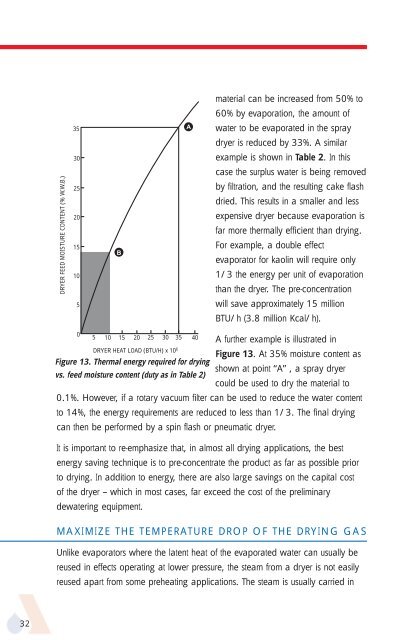APV Dryer Handbook - Umbc
APV Dryer Handbook - Umbc
APV Dryer Handbook - Umbc
You also want an ePaper? Increase the reach of your titles
YUMPU automatically turns print PDFs into web optimized ePapers that Google loves.
32<br />
DRYER FEED MOISTURE CONTENT (% W.W.B.)<br />
35<br />
30<br />
25<br />
20<br />
15<br />
10<br />
5<br />
0<br />
B<br />
A<br />
material can be increased from 50% to<br />
60% by evaporation, the amount of<br />
water to be evaporated in the spray<br />
dryer is reduced by 33%. A similar<br />
example is shown in Table 2. In this<br />
case the surplus water is being removed<br />
by filtration, and the resulting cake flash<br />
dried. This results in a smaller and less<br />
expensive dryer because evaporation is<br />
far more thermally efficient than drying.<br />
For example, a double effect<br />
evaporator for kaolin will require only<br />
1/3 the energy per unit of evaporation<br />
than the dryer. The pre-concentration<br />
will save approximately 15 million<br />
BTU/h (3.8 million Kcal/h).<br />
A further example is illustrated in<br />
DRYER HEAT LOAD (BTU/H) x 10<br />
Figure 13. At 35% moisture content as<br />
shown at point “A” , a spray dryer<br />
could be used to dry the material to<br />
0.1%. However, if a rotary vacuum filter can be used to reduce the water content<br />
to 14%, the energy requirements are reduced to less than 1/3. The final drying<br />
can then be performed by a spin flash or pneumatic dryer.<br />
6<br />
5 10 15 20 25 30 35 40<br />
Figure 13. Thermal energy required for drying<br />
vs. feed moisture content (duty as in Table 2)<br />
It is important to re-emphasize that, in almost all drying applications, the best<br />
energy saving technique is to pre-concentrate the product as far as possible prior<br />
to drying. In addition to energy, there are also large savings on the capital cost<br />
of the dryer – which in most cases, far exceed the cost of the preliminary<br />
dewatering equipment.<br />
MAXIMIZE THE TEMPERATURE DROP OF THE DRYING GAS<br />
Unlike evaporators where the latent heat of the evaporated water can usually be<br />
reused in effects operating at lower pressure, the steam from a dryer is not easily<br />
reused apart from some preheating applications. The steam is usually carried in











